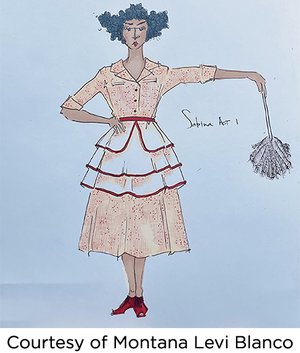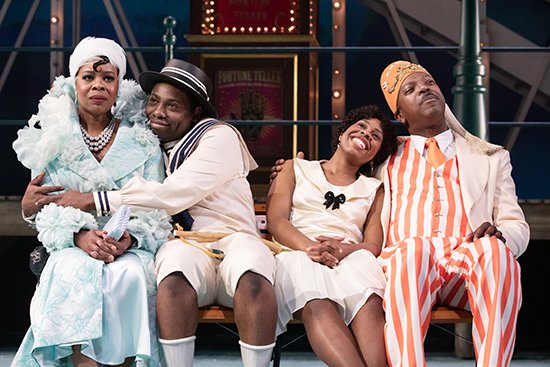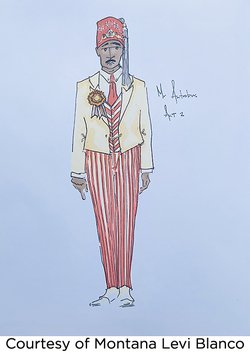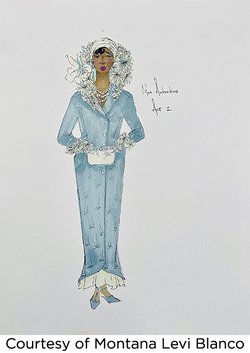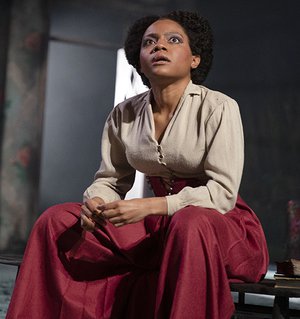The Skin of Our Teeth has a cast of 28 (not including dinosaurs). Each actor has at least three costume changes. Which means that Montana Levi Blanco, who for his work on the production this week received a Tony nomination for Best Costume Design of a Play, had to imagine and organize more than 100 looks to reflect the show’s distinct time periods: mid-20th-century American (act one); 1920s Atlantic City (act two); and American Civil War (act three).
When Blanco and I sat down to discuss this project there wasn’t time to discuss all the costumes. We focused on specific looks from each act: Sabina in act one, the Antrobus family in act two, Sabina again in act three.
In discussions with Lileana Blain-Cruz, the production’s director and Blanco’s frequent collaborator since they met at the Yale School of Drama, Blanco selected the color red as Sabina’s through-line – her through-hue. “But,” Blanco explained, “when one actor plays several characters, it’s important to create distance between those characters. Details help. Shoes change. Accessories change. Sabina’s first-act costume consists of a cream linen dress with a cross-hatch print on it. Over this is a silk-cream organza apron that has a red-satin piping. She wears peep-toe shoes, in carmine-red, a color that has a richness to it.”
“All Sabina’s looks are built,” Blanco explained, meaning that they are sewn or put together in a workshop. “About 50 percent of the show’s costumes are built, about 30 percent are rented – from big Hollywood places like Western Costume in L.A. – and about 20 percent are shopped: bought in stores or online.” Blanco said the costumes for the show’s refugees, who look more contemporary, were shopped. “In that sense,” he added, “the production has not three but four time periods.”
For the Antrobuses’ costumes in Act Two, Blanco did extensive historical research, a process, given the fact that one of his undergraduate degrees, from Oberlin, was a B.A. in history (the other was a music degree in oboe), he enjoys. “The Antrobuses are at a convention, of the Conveners,” Blanco said. “So we looked at photos of Shriners and Masons. Most of them were white people, but I found one of black Shriners, which got us excited. We were also inspired, in act one, by imagery from the 1950s of Jackie Robinson and his family, and, in act three, by imagery of a black Union soldier and his family.”
In act two, Mrs. Antrobus wears a long silk-brocade jacket. Her through-line is floral, so her second act look has a collar adorned with flowers. “Mr. Antrobus,” Blanco said, “is the president of the Conveners. He wears a pumpkin-and-cream-striped costume, which correlates with awnings that decorate the boardwalk. He also wears a fez. We wanted the Antrobus children, Henry and Gladys, to sport archetypal looks from the Twenties, so he’s wearing a sailor suit and she wears a simple sack dress with pleated skirt.”
When it came time to imagine Sabina in act three, Blanco and Blain-Cruz asked themselves: What would Sabina have been doing in the war? “Maybe she was a nurse,” Blanco said. “Whatever she was doing, we wanted her to be in the garment she would have been wearing to execute those duties. We made it more of a trouser than a skirt.” Sabina’s costume is heavily distressed at the bottom. “Because Sabina and the Antrobuses have just gone through the war,” Blanco said, “the distress functions as a metaphor for what they have endured.”
Blanco, who also designed the costumes for another Broadway show this season – the acclaimed musical A Strange Loop – said he is interested in expanding his career to include TV and film. “But my true love is the theater. Film and TV costumes are seen primarily above the waist. In theater, you’re seeing the entire costumes most of the time. Your work isn’t being edited by a director or cinematographer.”
Blanco said that regardless of whether his assignment is period or contemporary, he tries to involve the actors in the design process. For Brian Watkins’ new play Epiphany, for example, which is set in the present-day and is about to start previews in LCT’s Newhouse space, Blanco and director Tyne Rafaeli had hour-long meetings with each of the actors. “We asked them,” Blanco said, “how they envisioned their characters. We then moved forward by trying to find pieces to reflect with what was brought up in those conversations.”
As my chat with Blanco wound down, he shared one of his professional secrets. “I’m really interested in what actors wear the first day of rehearsal. It’s almost like the first day of school. I might notice, for example, that someone likes trousers with wide legs and small waists. I can use those clues in my work. I try to accommodate those things to help actors be their best onstage playing their characters and telling the story without having to think too much about their costumes.”
Brendan Lemon is the editor of lemonwade.com
